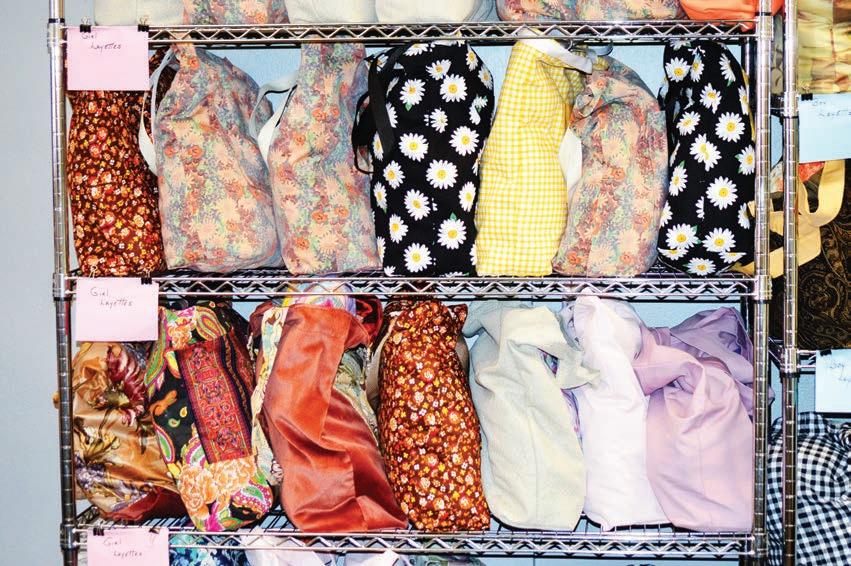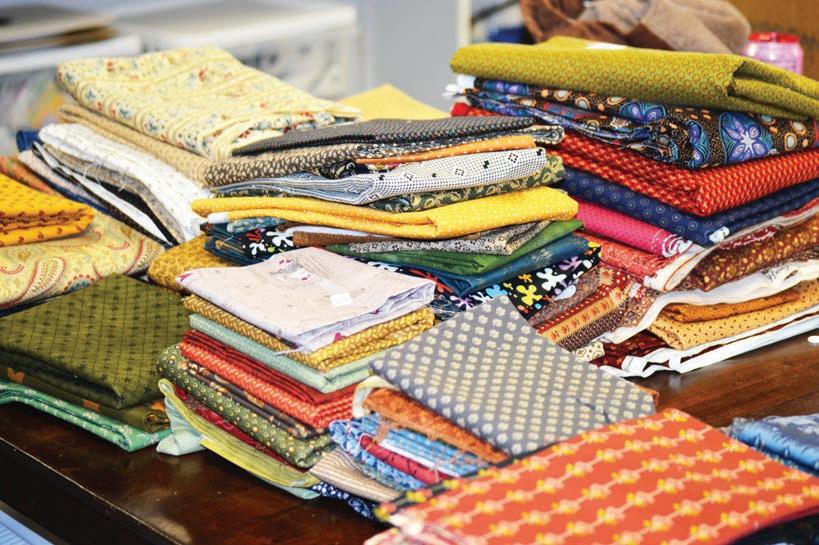
7 minute read
IN NEED
FROM PAGE 8 and joined the local work group there. e importance of the nonpro t’s work resonated with Williams after an interaction she had with a stranger a number of years ago, she said. e woman asked her what she was buying the materials for, to which Williams began to explain Warm Hearts Warm Babies.
“I was still up in Aurora, out buying onesies and things for our (goodie) bags so that we could deliver onesies and diapers and things, and a lady was standing behind me at the cash register,” Williams said.
“And she stopped me and she said, ‘ en, I need to thank you, because my daughter just had a baby at the hospital and it was wintertime and … we had nothing to bring that baby home in. And I told the nurses and they brought us one of your bags,’” Williams said.
“And so that keeps me going,” she continued. “I think about that and that keeps me going and seeing how important it is, the work we do.”
Fostering community
Materials for making items and assembling the layettes are stored in the nonpro t’s building, based in Arvada, which is nicknamed “ e Baby House.”
Among the volunteers who gathered at the building that Friday was Glenda Bredeson, an Arvada resident who has been a part of the organization since 1999.
Over time, the nonpro t has gradually grown and expanded in di erent areas of Colorado, said Bredeson, vice president of the nonpro t’s board.


Volunteering for the nonpro t has become a family a air, as Bredeson’s 18-year-old granddaughter, Eleanor Morris, worked alongside Bredeson in e Baby House.
“I remember volunteering here when I was a little girl,” Morris said, explaining she and her cousins would help assemble goodie bags. “I’ve always loved it.”
Since then, she began crocheting and knitting items to donate.
“She was thrilled when she made her rst two baby hats and brought them in,” Bredeson said.

Although Morris lives in Virginia, she visits when she can and also plans to still create items to donate and ship them to the nonpro t.
“I was so excited just to be here and volunteer because I grew up always coming here. Every time I visited, I would be here, and it was just amazing,” she said.
One of Bredeson’s favorite parts of the nonpro t is the people. Vickie Lutz, an Arvada resident who began volunteering for the organization in 2020, agreed and said that’s true for most of the volunteers.
Lutz said the nonpro t has incredibly talented volunteers. She showed o intricate blankets, toys and clothing items in e Baby House that volunteers spent hours creating.
Challenges and goals e talent of the volunteers isn’t just for making impressive items, though e need for more younger volunteers is a challenge the nonpro t faces.


— it can also be applied toward teaching younger people the craft.
“Eleanor came to us. She didn’t know how to knit or crochet, and now she’s phenomenal at it. ere are so many people here that are willing to teach,” Lutz said.
“We’re all older, and it’s just not going to be sustainable if we don’t get young people,” Lutz said.

Powis said the organization also needs more volunteers who will sew.
“ e last couple of months, unfortunately, we’ve had to cut back. We’ve had to cut back on the clothes,” Powis said. “We were sending out two out ts. Now it’s down to one.”
Before COVID-19, the nonpro t was able to have a backup supply of clothing, she said. Now, the organization is scraping by, month by month, due to losing a lot of active members.
On top of the need for volunteers, there are also nancial pressures.
“Our donations have gone down drastically over the last couple of years,” Powis said. “And again, our volunteers and the items coming in have really gone down — but the need is still the same — more, more.” e main goal she has for this year is getting enough donations of money and items to continue the nonpro t’s work.
To help raise funds to pay for costs such as rent, volunteers will create items to sell at various craft shows. e nonpro t is also one of the charities that people can select as part of the King Soopers Community Rewards program.

As the grant coordinator, Williams plans to work this year on nding new areas to get donations and support, she said. She noted that Sue Lee, cofounder of the nonpro t Sock It To ‘Em Sock Campaign, has helped by not only donating socks to Warm Hearts Warm Babies but also in providing connections to other people. e nonpro t creates 125 to 150 layettes every month, Powis said.
“ ere are other organizations out there that would love to have us help them, but at this point, we can’t go out and look for more agencies. But I know they’re there — I know there’s more mamas that could use the help,” she said. “I would (like) not only to be able to help who we have, but also for it to grow and help more.” ere are a variety of ways that community members can support Warm Hearts Warm Babies, Williams explained.
“Even if people don’t sew or … they don’t crochet, but they can help in, you know, at e Baby House or they can help in collecting donations for us — do a donation drive for us in their schools or their churches — to help us so that we can continue to help these mothers and babies and give them a good start in life,” Williams said.
Powis encouraged people to reach out to the nonpro t and come visit them. ose interested in learning more about Warm Hearts Warm Babies can visit warmheartswarmbabies. org. “We’re a world that needs to be more interactive with each other,” Powis said, emphasizing the importance of volunteering. “It’s so good for your soul.” all-time high and availability is at an all-time low.



“ is bill really does increase individual property rights,” Woodrow said. “If you are a property owner, you have the right to build an accessory dwelling unit and the government will not be able to prevent that. Some feel like we are taking away rights. We are adding to them. is bill will have some exibility, but it does set forth some minimum standards.”
Since the bill’s introduction, several Denver metro communities have passed resolutions to oppose the bill, including Westminster, Castle Rock, Lone Tree and Centennial. Other communities have said they may take similar votes.
At the center of the opposition is the plan for the state intervening in local development decisions, removing home rule authority. Home rule is a form or structure of governing dened by the citizens of a municipality or county that allows for more control over matters of local signi cance.
According to the proposed bill, municipalities will be required to submit land-use codes to the state. e state will review the proposed codes and if they are deemed insu cient, the state will impose its own codes.

Arapahoe County Commissioner Carrie Warren-Gully said the bill takes a one-size- ts-all approach and it will not work for all Colorado communities.
Woodrow said he disagrees, that the bill allows communities to develop and plan growth, but they have to meet minimum standards to avoid state intervention. He stressed the bill has tiers to address all populations, including suburban, urban and mountain towns.
“It is not a one-size- ts all,” he said. “ is only goes into e ect if a community refuses to adopt the (minimum) required standards. e only time you are a ected is if you decided to ignore it.” e reason the state is taking steps to intervene in local control is because of the excessive use of “exclusionary zoning,” by some Colorado communities, Woodrow said.

Exclusionary zoning laws place restrictions on the types of homes that can be built in a neighborhood. Oftentimes, these laws prohibit multifamily homes and set limits on building heights.
Rep. Lisa Frizell, R-Castle Rock, said SB23-213 is a misguided piece of legislation that does nothing more than declare war on single family home construction.
“It’s built on a faulty premise that everyone wants to live in high density housing,” she said.
Frizell said if the Democratic-led legislation wanted to adequately address the housing crisis, it would focus on the impact fees and permit fees that cities and towns are charging developers.
Pointing to Castle Rock as an example, Frizell said home prices have skyrocketed due to the costs home builders are having to pay local entities to build.
According to the fee sheet on the Town of Castle Rock website, a developer building a 2,000 square foot home can pay over $21,000 in impact fees, which includes a line item for parks and recreation, re protection, municipal facilities, police and transportation. at total does not include other required permit fees. e construction of a multifamily building is more than $17,000 per unit, according to the fee schedule.
In drafting the legislation, Moreno said the authors looked at what other states have done, speci cally naming California and Oregon, which have also implemented land-use codes.
Moreno said the steps taken by both the Democratic-led states would not t Colorado’s current and future needs.
“(SB23-213) is drafted to provided local options for municipalities to choose from,” he said. “ is sets goals and gives choices on how to meet those goals. It’s easy. If (municipalities) don’t then the state will step in. ere is a bit more choice than other states.”
In its early stages, Moreno said lawmakers have agreed not to immediately take votes on the proposed legislation, instead opting on April 6 to listening to debate, concerns and ideas.
Moreno said he has heard complaints that the bill does not address a ordability enough. e Adams County senator said amendments are likely as the bill moves through the process.








